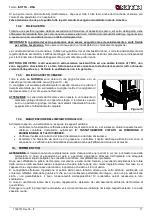
Termo
ISOTTA – DSA
7199701 Rev.05 – EN
27
The natural recirculation of air must be ensured by some fixed openings on the outside. The size of the necessary
openings for air is fixed by the relevant prescriptions. Ask information to your chimney sweeper. The openings should
be protected with grids and should never be obstructed.
An extraction hood (aspirating) installed in the same room or in a room nearby, causes depression with output of
combusted gasses (smoke, smell). As consequence it is necessary to ensure more flow of fresh air.
The depression in an extraction hood can at worst hypothesis, transforms the flue into an external air intake,
by sucking the smokes of the rooms with dangerous consequences for the people.
8.
ADMITTED/NOT ADMITTED FUEL
The fuel admitted is made of wood logs. One must use only logs of dry wood (water content max. 20 %). One must
load at maximum 2 or 3 logs of wood per time. The wood pieces should have a length of 30-40 cm’s and a maximum
circumference of 30-35 cm’s.
The wood used as fuel must have a moisture contents lower than 20%, which is obtained after at least 1 year drying
(tender wood) or 2 years (hard wood) and must be stored in a dry and ventilated place (for ex. Under a shed). The
wet wood makes ignition more difficult because it is necessary a greater quantity of energy to evaporate the existing
water. The humid contents has the disadvantage that, with the temperature lowering, the water condensates first in
the hearth and then in the chimney. The unseasoned wood contains about 60 % of H
2
0, and then it is not suitable to
be burnt.
Variety
Kg/mc
KWh/Kg Moistness 20%
Beech
750
4,0
Oak
900
4,2
Elm
640
4,1
Poplar
470
4,1
Larch*
660
4,4
Spruce*
450
4,5
Scots pine
*
550
4,4
* Resinous wood not suitable for the burning
Among the others, the following cannot be burnt: remainders of coal, cut-outs, scraps of bark and panels,
humid wood or treated with varnishes, plastic materials; in this case the warranty on the equipment expires.
Paper and carton must be used only for ignition.
The combustion of wastes is FORBIDDEN and may damage the stove and the chimney, causing health damages
and claims by the neighbourhood owing to the bad smell.
The wood is not a fuel, which allows a continuous operation of the appliance, as consequence the heating all over the
night is not possible.
ATTENTION: the continuous and protracted use of aromatic wood (eucalyptus, myrtle etc.) quickly damages the cast
iron parts (cleavage) of the product.
9.
LIGHTING
ATTENTION: For no reason must the fire be ignited before the system has been completely filled with water;
doing this would lead to serious damage of the entire structure.
IMPORTANT: The first time that the appliance is lit, there will be an odour given off (due to the drying of the
adhesives of the junction chord), which disappears after a short use. It must be ensured, in any case, a good
ventilation of the environment. Upon the first ignition we suggest loading a reduced quantity of fuel and
slightly increasing the calorific value of the equipment.
To perform a correct first lighting of the products treated with paints for high temperature, it is necessary to know the
following information:
•
the construction materials of the involved products are not homogeneous, as matter of fact there are
simultaneously parts in cast iron and steel.
•
the temperature to which the body of the product is subject is not homogeneous: from area to area, variable
temperatures within the range of 300°C - 500 °C are detected;
•
during its life, the product is subject to alternated lighting and extinguishing cycles in the same day, as well as
to cycles of intense use or of absolute standstill when season changes;
•
the new appliance, before being considered seasoned has to be subject to many start cycles to allow all
materials and paints to complete the various elastic stresses;
•
in detail, initially it is possible to remark the emission of smells typical of metals subject to great thermal
stress, as well as of wet paint. This paint, although during the manufacture it is backed at 250 °C fo r some
















































